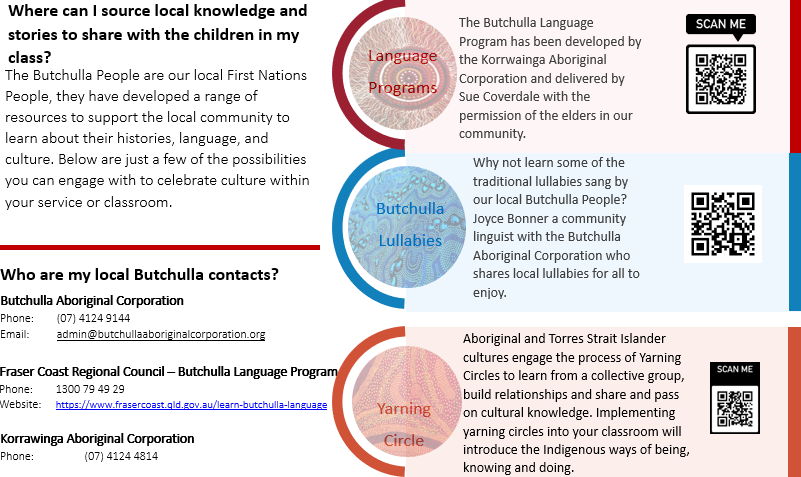8 Butchulla knowledge and stories
Tracey Mason
This resource was designed for early childhood professionals wishing to embrace the reconciliation process with the Butchulla people of the Great Sandy Region in South-East Queensland. It provides access to programs and initiatives that will enhance the educator’s knowledge and understanding of local Butchulla language and stories. Links to the Aboriginal pedagogy of being, knowing and doing, are provided, demonstrating the spiritual connection Aboriginal People have to their people, land, culture and language. Educators can access this resource in print or digital form. For ease of access to embedded links, QR codes and hyperlinked text are provided.
The Early Years Learning Framework discusses the right for all children to have access to education, an education that respects the child’s family, culture, identity and languages (DEEWR, 2009). When educators acknowledge the significance of traditional languages, they are acknowledging both the personal and cultural importance language holds within the lives of the children and families within their care (Arthur et al., 2021). USQ (2020) discusses the importance of educators taking responsibility for their professional learning to increase their knowledge and understanding of local Aboriginal histories, cultures and language. In doing so, educators are building the capacity of their children while strengthening the child’s sense of identity and belonging. Examples of how Aboriginal and Torres Strait Islander cultures, histories and languages can be immersed into the learning environment include incorporating local Aboriginal words such as names of animals, learning traditional songs and stories and sharing knowledge and experiences through a yarning circle. For centuries, Aboriginal and Torres Strait Islander cultures engaged the process of Yarning Circles to learn from a collective group, build relationships and share and pass on cultural knowledge through the Aboriginal ways of being, knowing and doing (Queensland Curriculum & Assessment Authority, 2020).
Links
Early Years Learning Framework (DEEWR, 2009)
- Outcome 1: Children have a strong sense of identity
- Outcome 2: Children are connected with and contribute to their world
- Outcome 5: Children are effective communicators
Queensland Kindergarten Learning Guidelines (QCAA, 2018)
- Identity: Building a confident self-identity
- Connectedness: Showing respect for diversity
National Quality Standard (ACECQA, 2018)
- Quality Area 1 – Educational program and practice
- 1.1.2 Child-centred: Each child’s current knowledge, strengths, ideas, culture, abilities and interests are the foundation of the program.


